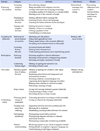Abstract
Purpose
The purpose of this study was to identify and describe cultural meanings for married Japanese immigrant women in rural Korean communities.
Methods
The informants were 10 women in rural areas. Data were collected from August 2017 to June 2018 through in-depth interviews and participant observations and analyzed using text analysis and taxonomic methods developed by Spradley.
Results
The meanings of adaptation were classified into five cultural domains: Practicing the doctrine, accepting the difference, redemption, true home, and confronting reality. The subthemes according to meanings of adaptation were comprised of international marriage with a sense of calling, bearing with sense of duty, and making a living substantively. The subthemes in this study reflect the process of adaptation. The cultural themes in the process of adaptation were overcoming differences and conflicts between Korea and Japan to achieve true family.
References
1. Ministry of Justice Korea Immigration service. Korea immigration service statistics 2017. Online [Internet]. 2018. cited 2018. May 5. 2017(12): 35 p. Available from: https://goo.gl/aA9wC1.
2. Chung HS, Kim YS, Yi TM, Ma KH, Choi YJ, Park GY, et al. An analysis on the national survey of multicultural families. Research Report. Seoul: Ministry of Gender Equality and Family;2016. 01. Report No. 2016-03.
3. Yeo JC. The formation and cultural adjustment of multicultural families. The Journal of Korean Cultural Studies. 2010; 44:351–388.
4. Kang YM, Shin HJ. A qualitative study on the successful adjusting process of immigrant wives in Korea. Korean Journal of Counseling. 2010; 11(4):1393–1410.

5. Berry JW. Acculturation: living successfully in two cultures. International Journal of Intercultural Relations. 2005; 29(6):697–712. DOI: 10.1016/j.ijintrel.2005.07.013.

6. Lee JH. A study of life history on Japanese immigrant wives in Korea. The Japanese Modern Association of Korea. 2012; 35:233–253.
7. Jo HM. Hybridized identity of marriage migrants from Japan. Korean Journal of Japanese Language and Literature. 2009; 45:521–544.
8. Kubo M. Cultural adaptation and mental health of Japanese immigrant women married Korean [master's thesis]. Seoul: Sangmyung National University;2015. 163.
9. Nam CM. A study on the influence that a religion affects the integration of family and the establishment of identity in a multi-cultural home-focused on the case of Japanese female believers in Tongilgyo who married Korean man. The Japanese Modern Association of Korea. 2017; 56:249–265.
10. Yim YE, Lee HJ. A study on the model of acculturation and multicultural acceptance attitude of Japanese residents in Korea. The Journal of Peace Studies. 2013; 14(4):187–205. DOI: 10.14363/kaps.2013.14.4.187.

11. Ishii H, Min KY, Seongok YH, Lee YS. Investigating the cultural identity of the Japanese marriage immigrant women in Korea. The Journal of Multicultural Society. 2015; 8(2):107–143. DOI: 10.15685/jms.2015.08.8.2.107.

12. Suh YI, Han JH. A study on the cultural psychological phenomenon experienced by married immigrant Japanese women during parenting. Korean Journal of Counseling. 2016; 17(5):465–486.

13. An HJ, Cho SS, Cho WT. The experience of history education related to Japan for middle and high school students with Japanese mothers. Journal of Regional Studies. 2011; 19(3):47–75.
14. Lee YN. Qualitative study on ‘becoming a mother' of married immigrant women in multi-cultural families: centered on Japanese mothers. Korean Journal of the Japan Education. 2015; 20(1):65–85.
15. Kim J, Park SH, Kim M, Kim SY. Exploring issues and strengths of cross-cultural marriage among Korean immigrants. Health Care for Women International. 2017; 38(10):1095–1114. DOI: 10.1080/07399332.2017.1360301.

16. Aamodt AM. Ethnography and epistemology: generating nursing knowledge. In : Morse JM, editor. Qualitative nursing research: a contemporary dialogue. Newbury park: Sage;1991. p. 344. DOI: 10.4135/9781483349015.n6.
17. Leininger MM. Qualitative research methods in nursing. Orlando FL: Grune & Stratton;1985. p. 361.
18. Moon SM. Peace world love. Paju: Gimmyoung Publications;2010. p. 383.
19. Mistuteru Y.
KG Lee
. Big hope. Seoul: AK Communications;2006.
20. Lee HH. Study on community participation of multicultural families' migrant women of in rural. Paju: EdamBooks;2010. p. 238.
21. Spradley JP. The ethnographic interview. New York: Holt, Rinehart and Winston;1979. p. 247.
22. Lincoln YS, Guba EG. Naturalistic inquiry. Newbury Park, CA: Sage;1985. p. 416.
23. Kim KJ. Thoughts on multicultural family issues in a new religion-focusing on Japanese immigrant wives of the unification church. Journal of the Korean Academy of New Religions. 2011; 24:327–361.
24. Ahn TY. A woman of empire who lived in the colony: colonialism and gender seen through Tsuda Setsuko's life in colonial Korea. Journal of Korean Women's Studies. 2008; 24(4):5–33.
25. Yang Al, Lee HS. In the late 1980s, marriage immigration in Japan, adjustment, depression, and trauma of Zainichi New Comer(2)-conflict between mother-in-law and daughter-inlaw, great east Japan earthquake. Journal of East Asian Cultures. 2017; 71:295–321.
26. Jung SJ. A Phenomenological study on family conflicts of Japanese married immigrant women: focused on family rituals [dissertation]. Seoul: Hanyang University;2018. 226.




 PDF
PDF ePub
ePub Citation
Citation Print
Print




 XML Download
XML Download